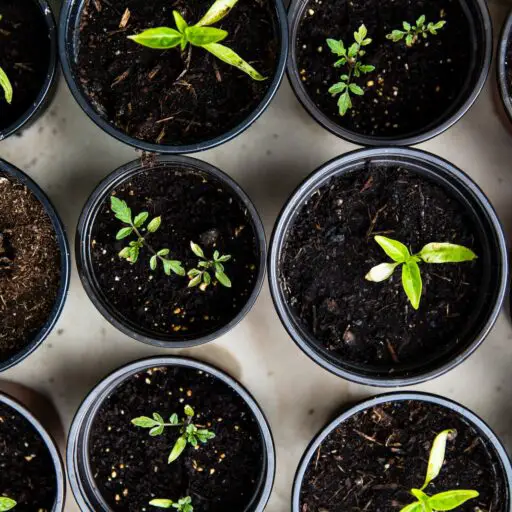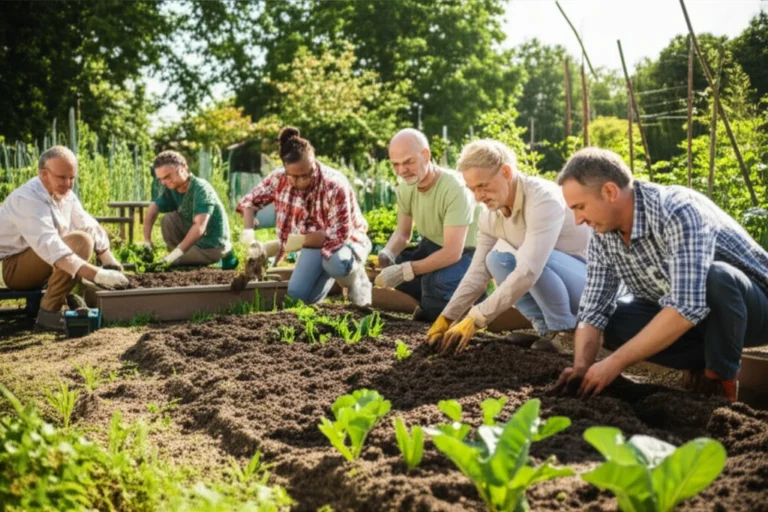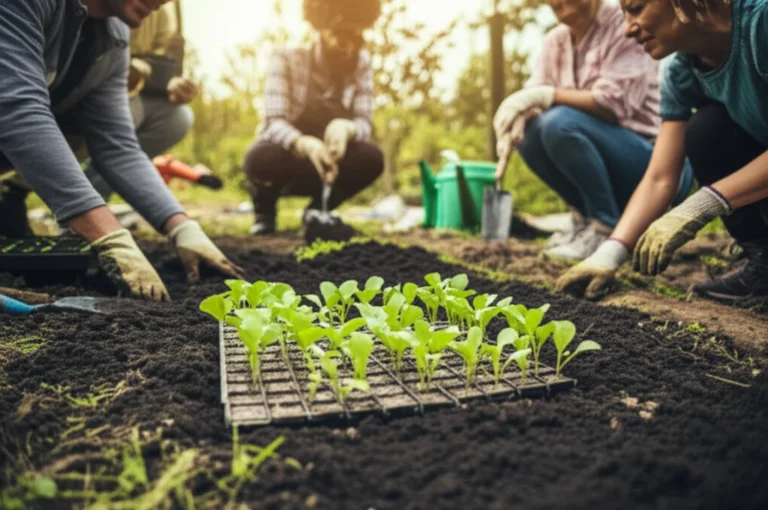Support our educational content for free when you purchase through links on our site. Learn more
Have you ever wondered why community gardens have become the heartbeats of neighborhoods worldwide? Beyond the fresh veggies and blooming flowers, these shared green spaces are buzzing with purpose, passion, and potential. From boosting food security to sparking social connections, the goals of a community garden stretch far beyond the soil. Stick around, and we’ll reveal 10 compelling reasons why these gardens matter more than ever—and how they might just transform your community (and your life!).
Here’s a teaser: Did you know that participating in a community garden can reduce stress, improve nutrition, and even empower local activism? Later, we’ll share inspiring stories from gardeners who’ve witnessed these benefits firsthand and practical tips to start your own thriving garden oasis.
Key Takeaways
- Community gardens aim to improve food security, environmental health, and social cohesion—making neighborhoods healthier and happier.
- They serve as educational hubs, teaching gardening skills, nutrition, and sustainability to all ages.
- These gardens promote mental and physical well-being through outdoor activity and therapeutic engagement.
- Community gardens can spark economic opportunities and foster civic engagement for local change.
- Overcoming challenges like land access and funding is possible with community collaboration and smart planning.
Ready to get growing? Check out trusted tools and supplies from Fiskars and Rain Bird to kickstart your garden journey:
Table of Contents
- ⚡️ Quick Tips and Facts: Sowing the Seeds of Knowledge
- 🌱 Roots of Togetherness: A Brief History of Community Gardening
- 🏡 Beyond the Fence: Unearthing the True Essence of a Community Garden
- 🎯 The Grand Harvest: Unpacking the Core Goals of Community Gardening
- 1. Cultivating Food Security & Access: From Plot to Plate 🥕
- 2. Nurturing Environmental Stewardship: Green Thumbs for a Greener Planet 🌎
- 3. Fostering Community & Social Cohesion: Growing Connections, One Seed at a Time 🤗
- 4. Promoting Health & Well-being: Digging for Wellness 💪
- 5. Empowering Education & Skill-Building: Learning from the Soil Up 📚
- 6. Driving Economic Opportunity & Local Resilience: Sprouting Prosperity 💰
- 7. Enhancing Urban Green Spaces & Biodiversity: A Haven for Nature 🦋
- 8. Providing Therapeutic & Recreational Outlets: Garden Zen 🧘♀️
- 9. Bridging Generational Gaps & Cultural Exchange: A Tapestry of Tales 🤝
- 10. Sparking Civic Engagement & Advocacy: Voices for Green Spaces 🗣️
- 🌟 Beyond the Goals: The Ripple Effect – Tangible Benefits of Community Gardens
- 🗺️ From Dream to Dirt: How to Start Your Own Community Garden Oasis
- 🚧 Weeding Out Worries: Common Challenges & Savvy Solutions in Community Gardening
- 💚 Our Green Thumb Tales: Inspiring Stories from Community Gardening™
- 🌿 Keeping the Green Dream Alive: Sustaining Your Community Garden for Generations
- 🏆 The Ever-Growing Legacy: Why Community Gardens Matter More Than Ever
- 🔗 Dig Deeper: Our Top Recommended Resources
- ❓ Sprouting Answers: Your Most Common Community Garden Questions Answered
- 📚 Our Roots: Sources and Further Reading
⚡️ Quick Tips and Facts: Sowing the Seeds of Knowledge
Welcome to the verdant world of community gardens! 🌿 At Community Gardening™, we’ve dug deep into what makes these shared green spaces tick. Here are some quick nuggets to get your gardening gloves on:
- Community gardens are more than just plots of land; they’re living classrooms, social hubs, and environmental sanctuaries.
- They boost food security by providing fresh, affordable produce to neighborhoods.
- Active participation improves physical and mental health—think of it as nature’s gym and therapy combined!
- These gardens strengthen social bonds, fostering a sense of belonging and cultural exchange.
- They often operate on volunteer power and donations, with some selling produce to sustain themselves.
- Urban biodiversity flourishes in these green oases, supporting pollinators and native plants.
- Community gardens can be a launchpad for local economic opportunities through farmers markets and workshops.
- Challenges include land access, funding, and volunteer coordination—but the rewards are worth every weed pulled!
Curious how these goals intertwine and why community gardens are sprouting up everywhere? Stick with us as we unearth the full story! 🌻
🌱 Roots of Togetherness: A Brief History of Community Gardening
Community gardens have been rooted in human culture for centuries, evolving from ancient communal plots to modern urban farms. During World Wars I and II, “Victory Gardens” became a patriotic way to supplement food supplies and boost morale. Fast forward to the 1970s and 80s, when urban decay and food deserts sparked a resurgence of community gardening as a form of grassroots activism and neighborhood renewal.
At Community Gardening™, we love how these gardens reflect the resilience and creativity of communities. Today, they’re not just about food—they’re about empowerment, education, and environmental stewardship. The history of community gardens is a testament to how people can come together to reclaim and transform spaces for the common good.
For more on the evolution of community gardens, check out the American Community Gardening Association’s history page.
🏡 Beyond the Fence: Unearthing the True Essence of a Community Garden
So, what exactly is a community garden? It’s a shared green space where local residents collectively grow fruits, vegetables, flowers, and herbs. But it’s also so much more:
- A place of learning, where novices and experts exchange gardening wisdom.
- A social hub, fostering friendships and cultural exchange.
- An environmental refuge, improving urban air quality and supporting wildlife.
- A platform for activism, addressing food justice and sustainability issues.
At Community Gardening™, we’ve seen firsthand how these spaces become microcosms of community spirit. They’re often managed by volunteer groups or nonprofits, with members sharing responsibilities like planting, watering, and organizing events. This cooperative approach is what truly defines a community garden.
Want to dive deeper? Our Garden Design Ideas section offers inspiration on how to create inviting, productive spaces.
🎯 The Grand Harvest: Unpacking the Core Goals of Community Gardening
Community gardens are like a well-tended patchwork quilt—each goal stitched carefully to create a vibrant whole. Let’s dig into the top 10 goals that drive these green sanctuaries:
1. Cultivating Food Security & Access: From Plot to Plate 🥕
One of the most tangible goals is to provide fresh, nutritious food to communities, especially in urban “food deserts.” Growing your own veggies means lower grocery bills and healthier diets. At Community Gardening™, we’ve seen families transform their eating habits after harvesting kale, tomatoes, and herbs right outside their door.
Benefits include:
- Increased access to organic produce
- Reduction in food miles and carbon footprint
- Educational opportunities about nutrition
Check out our Edible Plants category for beginner-friendly crops.
2. Nurturing Environmental Stewardship: Green Thumbs for a Greener Planet 🌎
Community gardens are urban lungs—they improve air quality, reduce heat islands, and foster biodiversity. They teach participants about composting, water conservation, and organic pest control. Our team swears by using Rain Bird drip irrigation systems for water efficiency, which you can find on Amazon.
Environmental wins:
- Habitat creation for pollinators like bees and butterflies
- Soil regeneration through organic practices
- Reduction of urban runoff and pollution
3. Fostering Community & Social Cohesion: Growing Connections, One Seed at a Time 🤗
At its heart, a community garden is about people. These spaces break down social barriers, encourage teamwork, and build trust. We’ve hosted potlucks and seed swaps that turned strangers into lifelong friends.
Social perks:
- Intergenerational bonding
- Cultural exchange through shared gardening traditions
- Strengthened neighborhood identity
4. Promoting Health & Well-being: Digging for Wellness 💪
Gardening is a full-body workout—digging, planting, weeding, and harvesting burn calories and build strength. Plus, exposure to sunlight boosts vitamin D, and being outdoors reduces stress and anxiety. A study published in the Environmental Evidence Journal confirms that community gardening improves both physical and mental health.
Health highlights:
- Increased physical activity
- Improved mood and reduced depression
- Enhanced cognitive function through learning
5. Empowering Education & Skill-Building: Learning from the Soil Up 📚
Community gardens are living classrooms. We’ve taught countless workshops on everything from seed starting to composting. These skills empower individuals to grow food independently and sustainably.
Educational benefits:
- Hands-on STEM learning for kids
- Adult education on nutrition and sustainability
- Leadership and project management experience
6. Driving Economic Opportunity & Local Resilience: Sprouting Prosperity 💰
Some community gardens evolve into micro-business hubs, selling produce at farmers markets or running classes. This creates jobs and stimulates local economies. Plus, growing food locally reduces dependency on fragile supply chains.
Economic impacts:
- Income generation through sales and workshops
- Cost savings on groceries
- Strengthened local food systems
7. Enhancing Urban Green Spaces & Biodiversity: A Haven for Nature 🦋
Urban areas often lack green spaces. Community gardens fill this gap, providing habitats for birds, insects, and native plants. We recommend planting native species like Echinacea and Milkweed to attract pollinators.
Biodiversity benefits:
- Increased species richness
- Improved ecosystem services
- Educational opportunities about native flora and fauna
8. Providing Therapeutic & Recreational Outlets: Garden Zen 🧘♀️
Gardening is therapeutic. We’ve seen participants use the garden as a stress-relief sanctuary, practicing mindfulness while tending to plants. Horticultural therapy is recognized by healthcare professionals for its mental health benefits.
Therapeutic perks:
- Reduced anxiety and depression symptoms
- Improved focus and relaxation
- Social engagement for isolated individuals
9. Bridging Generational Gaps & Cultural Exchange: A Tapestry of Tales 🤝
Community gardens are melting pots of culture and age. Elders share traditional growing methods, while youth bring new ideas and energy. This exchange enriches everyone involved.
Cultural and generational benefits:
- Preservation of heritage crops and techniques
- Cross-cultural understanding
- Intergenerational mentorship
10. Sparking Civic Engagement & Advocacy: Voices for Green Spaces 🗣️
Gardens often become launchpads for community activism—from advocating for more green spaces to influencing local food policies. Our volunteers have successfully lobbied city councils to protect garden land.
Civic impacts:
- Increased community participation
- Policy influence for urban agriculture
- Strengthened neighborhood advocacy networks
For more on community garden policies, visit our Community Garden Policies page.
🌟 Beyond the Goals: The Ripple Effect – Tangible Benefits of Community Gardens
The goals we’ve discussed create a ripple effect—benefits that extend beyond the garden fence. For example:
| Benefit Area | Tangible Outcome | Example from Community Gardening™ |
|---|---|---|
| Food Security | Reduced food insecurity | Families report better access to fresh food |
| Health & Wellness | Lower stress, increased physical activity | Participants report feeling happier and fitter |
| Social Cohesion | Stronger neighborhood ties | Garden potlucks and festivals bring people together |
| Environmental Impact | Improved urban biodiversity and air quality | Native pollinators thrive in garden habitats |
| Economic Resilience | Local job creation and savings | Garden markets provide supplemental income |
These benefits align with findings from EcoLife’s community garden overview, which highlights learning, relationships, and belonging as key outcomes.
🗺️ From Dream to Dirt: How to Start Your Own Community Garden Oasis
Ready to roll up your sleeves? Starting a community garden is a rewarding challenge. Here’s our step-by-step guide:
Plotting Your Course: Planning & Design Essentials
- Assess community interest: Host meetings to gauge enthusiasm.
- Choose a site: Look for accessible, sunny land with good soil or plan for raised beds.
- Design layout: Incorporate pathways, seating, compost areas, and water access.
- Plan crops: Select plants suited to your climate and community preferences.
Our Garden Design Ideas offers templates and inspiration.
Finding Your Footing: Land Acquisition & Permits
- Identify landowners: Approach city councils, schools, or private owners.
- Secure permissions: Obtain leases or agreements.
- Check zoning laws: Ensure gardening is allowed.
- Apply for permits: Water use, structures, and events may require permits.
Watering the Funds: Securing Grants & Resources
- Apply for grants: Look to organizations like the USDA’s Community Food Projects or local foundations.
- Crowdfund: Platforms like GoFundMe can rally community support.
- Partner with businesses: Local nurseries or hardware stores often donate supplies.
Cultivating Community: Recruitment & Governance
- Recruit volunteers: Use social media, flyers, and word-of-mouth.
- Establish rules: Create bylaws covering plot use, maintenance, and conflict resolution.
- Form committees: Delegate tasks like events, finances, and education.
- Host kickoff events: Build excitement and ownership.
🚧 Weeding Out Worries: Common Challenges & Savvy Solutions in Community Gardening
Community gardens are joyful but not without hurdles. Here’s how we tackle the usual suspects:
| Challenge | Solution | Community Gardening™ Tip |
|---|---|---|
| Land insecurity | Secure long-term leases or city partnerships | We partnered with our city’s parks dept. for a 10-year lease |
| Volunteer burnout | Rotate tasks, celebrate milestones | Monthly potlucks keep spirits high |
| Funding shortages | Diversify income streams | Selling seedlings at farmers markets helps fund tools |
| Pest and disease control | Use organic methods like neem oil and companion planting | We swear by planting marigolds to deter pests |
| Conflict among members | Establish clear guidelines and mediation | Regular meetings help air grievances |
💚 Our Green Thumb Tales: Inspiring Stories from Community Gardening™
Nothing beats the joy of watching a garden—and community—flourish. Here are a few stories from our team:
- Maria’s Miracle: A single mother who started with a tiny plot now teaches kids how to grow tomatoes and herbs, transforming her neighborhood’s food landscape.
- The Pollinator Project: Our volunteers created a butterfly garden that brought rare species back to the city, inspiring local schools to get involved.
- Healing Hands: A veteran found solace and rehabilitation through horticultural therapy at our garden, now leading mindfulness sessions for others.
These stories remind us that community gardens are living proof of hope, healing, and growth.
🌿 Keeping the Green Dream Alive: Sustaining Your Community Garden for Generations
Long-term success requires nurturing more than plants. Here’s how to keep your garden thriving:
- Develop leadership pipelines: Train new coordinators regularly.
- Maintain transparent finances: Use tools like QuickBooks or Wave for bookkeeping.
- Engage youth: Partner with schools for ongoing programs.
- Adapt to change: Be flexible with crops and activities as community needs evolve.
- Celebrate milestones: Annual harvest festivals keep enthusiasm alive.
Sustainability is a garden of many hands—the more you cultivate community, the stronger your roots.
🏆 The Ever-Growing Legacy: Why Community Gardens Matter More Than Ever
In an era of climate change, urban sprawl, and social isolation, community gardens are beacons of resilience and hope. They address pressing issues like food insecurity, mental health, and environmental degradation while knitting communities closer together.
As the Environmental Evidence Journal puts it, community gardening is “a complex multi-factorial activity” with multiple direct and indirect benefits. At Community Gardening™, we believe these green spaces are essential to building healthy, vibrant, and sustainable communities.
🔗 Dig Deeper: Our Top Recommended Resources
Want to grow your knowledge and garden? Here are some trusted resources:
- American Community Gardening Association: communitygarden.org — Comprehensive guides and networking.
- USDA Community Food Projects: usda.gov — Grants and support for food security projects.
- Rain Bird Drip Irrigation Systems: Amazon search — Efficient watering solutions.
- Local Harvest: localharvest.org — Find farmers markets and community gardens near you.
- Community Gardening™ Blog: Benefits of Community Gardens — Insights and stories from our team.
❓ Sprouting Answers: Your Most Common Community Garden Questions Answered
Q: How do I find a community garden near me?
A: Check local parks and recreation departments, community centers, or use directories like American Community Gardening Association’s garden finder.
Q: What if I don’t have gardening experience?
A: No worries! Community gardens are learning spaces. Many offer workshops and mentorship. Start small with easy crops like lettuce or radishes.
Q: Can I sell produce from a community garden?
A: Some gardens allow sales to support maintenance costs. Check your garden’s rules and local regulations.
Q: How do community gardens handle conflicts?
A: Most have bylaws and committees to mediate disputes. Open communication is key.
Q: What tools and supplies do I need?
A: Basic tools include gloves, trowels, watering cans, and compost bins. Brands like Fiskars and Corona are reliable choices.
For more FAQs, visit our Community Garden Events and Community Garden Policies sections.
📚 Our Roots: Sources and Further Reading
- EcoLife. (n.d.). Community Garden. Retrieved from https://www.ecolife.com/dictionary/community-garden
- Environmental Evidence Journal. (2017). Health and well-being impacts of community gardening: a systematic review. https://environmentalevidencejournal.biomedcentral.com/articles/10.1186/2047-2382-3-20
- American Community Gardening Association. History of Community Gardens. https://communitygarden.org/resources/history-of-community-gardens/
- USDA Community Food Projects. https://www.usda.gov/about-food/food-safety/food-security
Ready to grow your own community garden or join one? Dive into our Garden Design Ideas and Edible Plants categories to get started today! 🌻
Conclusion
Community gardens are much more than shared plots of soil—they are vibrant ecosystems of food security, environmental stewardship, social connection, education, and empowerment. As we’ve explored, the goals of community gardening weave together to create a tapestry of benefits that nourish not only plants but people and neighborhoods alike. Whether you’re seeking to improve your health, build friendships, or spark local change, community gardens offer a fertile ground for growth.
Remember those unanswered questions about how these gardens impact health and community? The evidence is clear: active participation leads to improved physical and mental well-being, stronger social bonds, and a deeper connection to nature. The challenges—land access, funding, volunteer coordination—are real but surmountable with passion and collaboration.
At Community Gardening™, we confidently recommend embracing or starting a community garden as a powerful, accessible tool to cultivate resilience and joy in your community. So why wait? Grab your gloves, rally your neighbors, and watch your shared garden—and community—flourish!
Recommended Links
👉 CHECK PRICE on:
-
Rain Bird Drip Irrigation Systems:
Amazon | Rain Bird Official Website -
Fiskars Garden Tools:
Amazon | Fiskars Official Website -
Corona Garden Tools:
Amazon | Corona Official Website -
Books on Community Gardening & Urban Agriculture:
FAQ
What are the benefits of participating in a community garden?
Participation offers a multitude of benefits: improved physical health through exercise, enhanced mental well-being by reducing stress, increased access to fresh produce, and opportunities for social interaction. Studies, including one from the Environmental Evidence Journal, confirm these positive impacts. Community gardens also foster environmental awareness and provide educational experiences.
How do community gardens bring people together and build relationships?
Community gardens act as social hubs, where people from diverse backgrounds collaborate toward a common goal. Shared tasks like planting and harvesting encourage teamwork and communication. Events such as potlucks and workshops further strengthen bonds. These interactions build trust, reduce social isolation, and create a sense of belonging.
What types of activities can be done in a community garden besides gardening?
Beyond planting, community gardens host a variety of activities:
- Educational workshops on composting, cooking, and sustainability
- Therapeutic sessions like horticultural therapy and mindfulness
- Cultural celebrations and festivals
- Youth programs and school partnerships
- Farmers markets and seed swaps
These activities enrich the community experience and broaden the garden’s impact.
Can community gardens help address food insecurity and nutrition in local communities?
Absolutely! By providing fresh, affordable produce, community gardens improve access to nutritious foods, especially in urban food deserts. They also educate participants about healthy eating and sustainable food systems, empowering communities to take control of their nutrition and reduce reliance on processed foods.
How do community gardens promote sustainability and environmental stewardship?
Community gardens use organic growing methods, composting, and water conservation techniques that reduce environmental impact. They increase urban green spaces, support pollinators, and improve soil health. By engaging people in sustainable practices, these gardens foster long-term environmental responsibility.
What role do community gardens play in educating people about gardening and nutrition?
They serve as living classrooms where people of all ages learn practical skills—from seed starting to pest management—and gain knowledge about nutrition and food systems. This hands-on education builds confidence and encourages healthier lifestyle choices.
How can community gardens be used as a tool for community development and social change?
Community gardens empower residents to take ownership of their neighborhoods, fostering civic engagement and advocacy. They can be platforms for addressing social issues like food justice, environmental equity, and urban renewal. By bringing diverse groups together, gardens build social capital and inspire collective action.
Reference Links
- EcoLife. Community Garden. Retrieved from https://www.ecolife.com/dictionary/community-garden
- Environmental Evidence Journal. Health and well-being impacts of community gardening: a systematic review. https://environmentalevidencejournal.biomedcentral.com/articles/10.1186/2047-2382-3-20
- American Community Gardening Association. History of Community Gardens. https://communitygarden.org/resources/history-of-community-gardens/
- USDA Community Food Projects. https://www.usda.gov/about-food/food-safety/food-security
- Rain Bird Official Website: https://www.rainbird.com
- Fiskars Gardening Tools: https://www.fiskars.com/en-us/gardening-and-yard-care/products
- Corona Tools: https://www.coronatools.com
Ready to join the green revolution? Explore our Community Garden Events and Benefits of Community Gardens for more inspiration! 🌿





